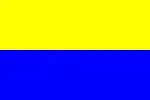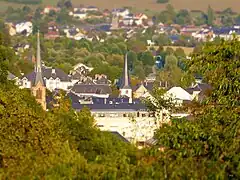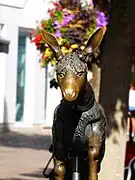Diekirch
Dikrech, Dikrich | |
|---|---|
 | |
 Flag  Coat of arms | |
 Map of Luxembourg with Diekirch highlighted in orange, and the canton in dark red | |
| Coordinates: 49°52′05″N 6°09′24″E / 49.8681°N 6.1567°E | |
| Country | |
| Canton | Diekirch |
| Area | |
| • Total | 12.42 km2 (4.80 sq mi) |
| • Rank | 87th of 102 |
| Highest elevation | 396 m (1,299 ft) |
| • Rank | 54th of 102 |
| Lowest elevation | 187 m (614 ft) |
| • Rank | 20th of 102 |
| Population (2023) | |
| • Total | 7,295 |
| • Rank | 21st of 102 |
| • Density | 590/km2 (1,500/sq mi) |
| • Rank | 15th of 102 |
| Time zone | UTC+1 (CET) |
| • Summer (DST) | UTC+2 (CEST) |
| LAU 2 | LU0000603 |
| Website | diekirch.lu |
Diekirch (French pronunciation: [dikiʁʃ]; German pronunciation: [ˈdiːkɪʁç]; Luxembourgish: Dikrech [ˈdikʀəɕ] ⓘ or (locally) Dikrich [ˈdikʀiɕ]; from Diet-Kirch, i.e. "people's church") is a commune with town status in north-eastern Luxembourg, capital city of the canton Diekirch and, until its abolition in 2015, the district of Diekirch. The town is situated on the banks of the Sauer river.
The town's heraldic shield, showing a crowned lion on a castle, was granted in 1988. It is based on the town's 14th-century seal and arms.[1]
In 2001, the town of Diekirch itself, which lies in the south of the commune, had a population of 6,068.
in 1977, Diekirch was the first town in Luxembourg to have a pedestrian zone.
Diekirch is home to a brewery of national importance carrying the town's name.
Three secondary schools are located in Diekirch: Lycée classique de Diekirch, Lycée technique hôtelier Alexis Heck and Nordstadlycée.[2]
The town is home to the national operational headquarters of the Luxembourgish Army at the Haerebierg Military Centre (located on the hill Herrenberg) and the National Museum of Military History, reflecting Diekirch's pivotal role in the famous Battle of the Bulge, called by the Germans Rundstedt-Offensive, a major battle of World War II. It was here that the river Sauer was crossed on the night of January 18, 1945, by the US 5th Infantry division.
The town is also the seat of one of the six regional headquarters of the Grand Ducal Police and one of Luxembourg's two judicial districts.
As far as sports events are concerned, Diekirch has gained a reputation for its annual cross country running competition — the Eurocross — which is an IAAF permit meeting and attracts world-class runners, with Gabriela Szabo and Irina Mikitenko among its past winners.[3]
History
The town received its name, according to old sources, when Charlemagne in the late 8th century resettled Saxons, in order to bring them under his control. One of the centre of these settlements was in the area of Diekirch. In order to convert the pagan Saxons to Christianity, a church was built, which gave the settlement its name: "Diet-Kirch" ("people's church"). In Old Franconian, thiuda (Old High German: "diot" - the people). Þeudō is a reconstructed word from Germanic, which plays a role in the etymology of the term "Deutsch".
In the 14th century, John, the blind king of Bohemia, fortified it, surrounding the place with a castellated wall and a ditch supplied by a stream. It remained more or less fortified until the beginning of the 19th century when the French, during their occupation, levelled the old walls and substituted avenues of trees.[4]
In the course of extensive excavation in the 1960s, it was shown that the St. Laurence church is a Roman building. In the early 20th century, wall ruins and mosaics were found north of the town center. Archaeological investigations in 1992–1993, 1999, and 2008 enabled the reconstruction of a large Roman villa, which extended over all the land of the medieval town and was abandoned in the early 5th century.

Diekirch is the host city and namesake of the "International March of Diekirch", a 20km up to 40km military road march event. The march commemorates John the Blind and invites both Military Members and civilians to participate and to pursue earning the Medal of the "Marche de L’Armée", a Luxembourgish Army award. The marches of 2020 and 2021 were canceled due to the Coronavirus Pandemic and were scheduled to be canceled again in the summer of 2022, but march officials decided to conduct the march as a virtual event to ensure its continuance and to invite an international audience to participate. The march drew significant interest from Service Members throughout the NATO area of influence, most notably the United States Army. The 492nd Civil Affairs Battalion based out of Buckeye, Arizona was notable for hosting the largest individual marching event in the United States and for the participation of Embassy representation. In 2023 the march returned to being only held as a live event in Diekirch.[5][6][7]
Mascot
The town's mascot is the donkey. There is a donkey fountain in the centre of Diekirch. The yearly cavalcade (carnival procession) is held under the sign of the donkey.
Population
Notable people

- Paul Eyschen (1841–1915), a Luxembourgish politician, statesman, lawyer and diplomat. He was the 8th Prime Minister of Luxembourg, serving for 27 years, 1888–1915.
- Alphonse Munchen (1850–1917), a Luxembourgish engineer and politician; Mayor of Luxembourg City from 1904 to 1915.
- Joseph Bech (1887–1975), a Luxembourgish politician and lawyer. He was the 15th Prime Minister of Luxembourg, serving for 11 years, from 1926 to 1937.
- Henri Losch (1931–2021), a Luxembourgish actor, writer, and teacher.
- Ali Kaes (born 1955) a Luxembourgish politician, mayor of Tandel
- General Gaston Reinig (born 1956) a Luxembourgian soldier and a former Chief of Defence of the Luxembourg Army
Sport
- Alfred Albert Joe de Re la Gardiur (1881–1941), a Professional wrestler.
- Léon Roth (born 1926) a Luxembourgian sprint canoer, competed in the 1952 Summer Olympics
- Johnny Lucas (1931–1993) a Luxembourgian sprint canoer, competed in the 1952 Summer Olympics
- Michael Pinto (born 1993) a Portuguese footballer, played over 250 games and 31 for Luxembourg
Twin towns — sister cities
.svg.png.webp) Arlon, Belgium
Arlon, Belgium Bitburg, Germany since 1962
Bitburg, Germany since 1962 Hayange, France
Hayange, France Liberty, United States
Liberty, United States.svg.png.webp) Monthey, Switzerland
Monthey, Switzerland
Gallery
 Diekirch city centre
Diekirch city centre The Old Church of St Lawrence was built on a Gallo Roman base
The Old Church of St Lawrence was built on a Gallo Roman base The Wirtgensschlass or Schloss Wirtgen is nowadays used as one building of the conservatory of music.
The Wirtgensschlass or Schloss Wirtgen is nowadays used as one building of the conservatory of music. Detail of one of the donkey fountains in the city centre
Detail of one of the donkey fountains in the city centre Fountains in the municipal park
Fountains in the municipal park The Sauer river flows through Diekirch.
The Sauer river flows through Diekirch.
References
- ↑ "Diekirch". ngw.nl. 9 September 2022.
- ↑ "Nordstad-Lycée Diekirch NOSL". NOSL.
- ↑ "untitled". arrs.run.
- ↑ One or more of the preceding sentences incorporates text from a publication now in the public domain: Chisholm, Hugh, ed. (1911). "Diekirch". Encyclopædia Britannica. Vol. 8 (11th ed.). Cambridge University Press. p. 209.
- ↑ Winkie, Davis (2022-12-23). "Army reinstates foreign footmarch awards after backlash, review". Army Times. Retrieved 2023-05-20.
- ↑ "Marche Internationale de Diekirch". www.marche.lu. Retrieved 2023-05-20.
- ↑ "492nd Civil Affairs Battalion conducts Rising Phoenix Battalion March, Marche Internationale de Diekirch". DVIDS. Retrieved 2023-05-20.
- ↑ "Population par canton et commune". statistiques.public.lu. Archived from the original on 2016-09-12. Retrieved 11 January 2022.
- ↑ "La ville". diekirch.lu (in French). Diekirch. Retrieved 2019-09-03.
External links
 Media related to Diekirch at Wikimedia Commons
Media related to Diekirch at Wikimedia Commons- Official website
- 492nd Civil Affairs Battalion conducts Rising Phoenix Battalion March, Marche Internationale de Diekirch
